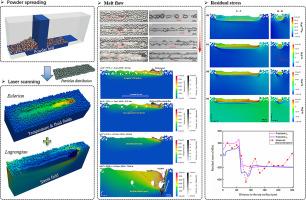A finite volume–based thermo-fluid-mechanical model of the LPBF process
IF 7.1
1区 工程技术
Q1 ENGINEERING, MECHANICAL
International Journal of Mechanical Sciences
Pub Date : 2024-09-29
DOI:10.1016/j.ijmecsci.2024.109759
引用次数: 0
Abstract
The multi-physics coupling feature of the laser powder bed fusion (LPBF) process poses great challenges to numerical models regarding computational fidelity and efficiency. This paper proposed a finite volume–based model for predicting integrated thermo-fluid-mechanical behaviors of the LPBF process. The model directly unifies the heat transfer, fluid flow and solid mechanics simulations within a predefined mesh, enabling simultaneous solutions for the fluid domain under Eulerian description and the solid domain under Lagrangian description. Three benchmark tests accounting for individual problems were conducted to validate the model's accuracy and effectiveness. Track-scale LPBF simulations were performed to unravel the intricate interplay between thermal, fluid and mechanical behaviors. The numerical predictions of surface morphologies, molten pool dynamics and melt track dimensions aligned well with the experimental observations. The spatiotemporal evolution of transient thermal stress was accurately captured and the predicted residual stress field showed consistency with nanoindentation measurements. The proposed model was found robust in simultaneously predicting the temperature distribution, melt flow and residual stress evolutions of the LPBF process, and showed strong potential for addressing other similar multi-physics coupling problems.

基于有限体积的 LPBF 工艺热流体力学模型
激光粉末床熔融(LPBF)工艺的多物理场耦合特性对数值模型的计算保真度和效率提出了巨大挑战。本文提出了一种基于有限体积的模型,用于预测 LPBF 工艺的热-流-机综合行为。该模型将传热、流体流动和固体力学模拟直接统一在一个预定义网格中,实现了欧拉描述下的流体域和拉格朗日描述下的固体域的同步求解。为验证该模型的准确性和有效性,针对个别问题进行了三次基准测试。进行了轨道尺度 LPBF 模拟,以揭示热、流体和机械行为之间错综复杂的相互作用。对表面形态、熔池动态和熔轨尺寸的数值预测与实验观测结果十分吻合。瞬态热应力的时空演变被准确捕捉,预测的残余应力场与纳米压痕测量结果一致。发现所提出的模型在同时预测 LPBF 过程的温度分布、熔体流动和残余应力演变方面非常稳健,并显示出解决其他类似多物理场耦合问题的强大潜力。
本文章由计算机程序翻译,如有差异,请以英文原文为准。
求助全文
约1分钟内获得全文
求助全文
来源期刊

International Journal of Mechanical Sciences
工程技术-工程:机械
CiteScore
12.80
自引率
17.80%
发文量
769
审稿时长
19 days
期刊介绍:
The International Journal of Mechanical Sciences (IJMS) serves as a global platform for the publication and dissemination of original research that contributes to a deeper scientific understanding of the fundamental disciplines within mechanical, civil, and material engineering.
The primary focus of IJMS is to showcase innovative and ground-breaking work that utilizes analytical and computational modeling techniques, such as Finite Element Method (FEM), Boundary Element Method (BEM), and mesh-free methods, among others. These modeling methods are applied to diverse fields including rigid-body mechanics (e.g., dynamics, vibration, stability), structural mechanics, metal forming, advanced materials (e.g., metals, composites, cellular, smart) behavior and applications, impact mechanics, strain localization, and other nonlinear effects (e.g., large deflections, plasticity, fracture).
Additionally, IJMS covers the realms of fluid mechanics (both external and internal flows), tribology, thermodynamics, and materials processing. These subjects collectively form the core of the journal's content.
In summary, IJMS provides a prestigious platform for researchers to present their original contributions, shedding light on analytical and computational modeling methods in various areas of mechanical engineering, as well as exploring the behavior and application of advanced materials, fluid mechanics, thermodynamics, and materials processing.
 求助内容:
求助内容: 应助结果提醒方式:
应助结果提醒方式:


